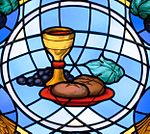
Back Nagmaal Afrikaans Eucharistie ALS أفخارستيا Arabic ܩܘܪܒܢܐ ARC تناول ARZ Eucaristía AST Yevxaristiya Azerbaijani Eukaristiya BCL Еўхарыстыя Byelorussian Евхаристия Bulgarian
| Part of a series on the |
| Eucharist |
|---|
 |
| Part of a series on |
| Christianity |
|---|
 |
The Eucharist (/ˈjuːkərɪst/ YOO-kər-ist; from Koinē Greek: εὐχαριστία, romanized: evcharistía, lit. 'thanksgiving'), also called Holy Communion, the Blessed Sacrament or the Lord's Supper, is a Christian rite, considered a sacrament in most churches and an ordinance in others. Christians believe that the rite was instituted by Jesus at the Last Supper, the night before his crucifixion, giving his disciples bread and wine. Passages in the New Testament state that he commanded them to "do this in memory of me" while referring to the bread as "my body" and the cup of wine as "the blood of my covenant, which is poured out for many".[1][2] According to the synoptic Gospels this was at a Passover meal.[3]
The elements of the Eucharist, bread, either leavened or unleavened, and wine (non-alcoholic grape juice in some Protestant traditions), are consecrated on an altar or a communion table and consumed thereafter. The consecrated elements are the end product of the Eucharistic Prayer.[4] Christians generally recognize a special presence of Christ in this rite, though they differ about exactly how, where, and when Christ is present.
The Catholic Church states that the Eucharist is the body and blood of Christ under the species of bread and wine. It maintains that by the consecration, the substances of the bread and wine actually become the substances of the body and blood of Jesus Christ (transubstantiation) while the appearances of the bread and wine remain unaltered (e.g. colour, taste, feel, and smell). The Eastern Orthodox and Oriental Orthodox churches agree that an objective change occurs of the bread and wine into the body and blood of Christ. Lutherans believe the true body and blood of Christ are really present "in, with, and under" the forms of the bread and wine, known as the sacramental union.[5] Reformed Christians believe in a real spiritual presence of Christ in the Eucharist.[6] Anglican eucharistic theologies universally affirm the real presence of Christ in the Eucharist, though Evangelical Anglicans believe that this is a spiritual presence, while Anglo-Catholics hold to a corporeal presence.[7][8] As a result of these different understandings, "the Eucharist has been a central issue in the discussions and deliberations of the ecumenical movement."[3]
- ^ Luke 22:19–20, 1 Corinthians 11:23–25
- ^ Wright, N. T. (2015). The Meal Jesus Gave Us: Understanding Holy Communion (Revised ed.). Louisville, Kentucky. p. 63. ISBN 9780664261290.
{{cite book}}: CS1 maint: location missing publisher (link) - ^ a b "Encyclopædia Britannica, s.v. Eucharist". Britannica.com. Retrieved 1 April 2023.
- ^ "Keeping the Feast: Thoughts on Virtual Communion in a Lockdown Era". 27 March 2020. Retrieved 21 August 2023.
- ^ Mattox, Mickey L.; Roeber, A. G. (2012). Changing Churches: An Orthodox, Catholic, and Lutheran Theological Conversation. Wm. B. Eerdmans Publishing. p. 54. ISBN 978-0802866943.
In this "sacramental union", Lutherans taught, the body and blood of Christ are so truly united to the bread and wine of the Holy Communion that the two may be identified. They are at the same time body and blood, bread and wine. This divine food is given, more-over, not just for the strengthening of faith, nor only as a sign of our unity in faith, nor merely as an assurance of the forgiveness of sin. Even more, in this sacrament the Lutheran Christian receives the very body and blood of Christ precisely for the strengthening of the union of faith. The "real presence" of Christ in the Holy Sacrament is the means by which the union of faith, effected by God's Word and the sacrament of baptism, is strengthened and maintained. Intimate union with Christ, in other words, leads directly to the most intimate communion in his holy body and blood.
- ^ McKim, Donald K. (1998). Major Themes in the Reformed Tradition. Wipf and Stock Publishers. p. 263. ISBN 978-1579101046.
- ^ Poulson, Christine (1999). The Quest for the Grail: Arthurian Legend in British Art, 1840–1920. Manchester University Press. p. 40. ISBN 978-0719055379.
By the late 1840s Anglo-Catholic interest in the revival of ritual had given new life to doctrinal debate over the nature of the Eucharist. Initially, 'the Tractarians were concerned only to exalt the importance of the sacrament and did not engage in doctrinal speculation'. Indeed they were generally hostile to the doctrine of transubstantiation. For an orthodox Anglo-Catholic such as Dyce the doctrine of the Real Presence was acceptable, but that of transubstantiation was not.
- ^ Campbell, Ted (1996). Christian Confessions: A Historical Introduction. Westminster John Knox Press. p. 325. ISBN 9780664256500.